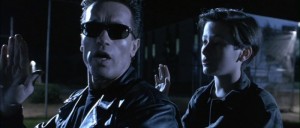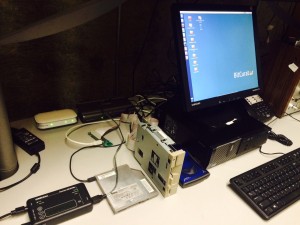The following post was authored by Digital Archivist Paul Kelly.
In the last two weeks we’ve covered paper and web pages. My job here is done, right? Wrong! Sometimes, we receive collections containing not just paper, but floppy discs, flash drives, and even entire computers. The list goes on. How do we go about processing this stuff?
To begin, it’s essential to have not only data carriers, but also players. Ever seen one of those elephant graveyards? We have something similar in our facility, but with old technology instead of, um, bones. Of course, older hardware was never designed to work on modern computers. We get around this by sticking to external USB drives whenever possible, and using an external control board for 5.25 floppies (FC5025, oh my!) that effectively duct tape an old IDE interface onto, you guessed it, USB.

Did you know that you can alter a computer file simply by opening it? Don’t believe me? Just right-click your desktop and arrange the icons by “last modified”. The very act of saving that last click is an archival deadly sin. Sometimes a piece of media will let you prevent alteration by flicking a switch on the item itself (3.5 floppy discs) or by covering a hole with a piece of tape (5.25 floppy discs). With other carriers, though, you can be fresh out of luck. What can we do about this? In short, by borrowing techniques from law enforcement. Software like Forensic Toolkit (FTK) in conjunction with write-blocking hardware has been used to gather evidence of computer crime for years. Why not apply that technology to archives work? In spring 2015, CUA Archives set up its own digital curation workstation for this very purpose.
So you’ve got your hardware – what do you do with it? You need an operating system designed to deal with this stuff, and FTK ain’t cheap (think thousands of dollars). Luckily, archivists at UNC Chapel Hill and the Maryland Institute for Technology in the Humanities are on the case, and developed a suite of open-source tools, known as BitCurator, that lets you document, copy, and extract information from any USB-connected source, leaving the original untouched.

So why does this even matter? Time to get personal. I got into this field after reading about rediscovered lost scenes from Fritz Lang’s 1927 film Metropolis. I’m willing to bet that most archivists have a story like that. One day, something similarly significant is going to be found on a 100 year old hard drive. We need to keep the past alive and inspire with our collections, and applying forensic techniques to archival problems gives us more ways to find that golden content. Take, for example, BitCurator’s ability to extract “deleted” files. Now, there’s a moral question here, but imagine looking at discs from a long-dead author and being able to read deleted drafts. That’s scholar-dream territory right there.
So far, we’ve extracted files from discs in the Thomas More Society of America and Cooper-Herzfeld collections. Small potatoes in the long-run, but we’re just getting started. We’re now set up to handle various media types, and intend to make some of the material we safely extract available through our finding aids. Watch this space.

One thought on “The Archivist’s Nook: Digital Curation – Sent from the Future to Write-Protect You”
Comments are closed.